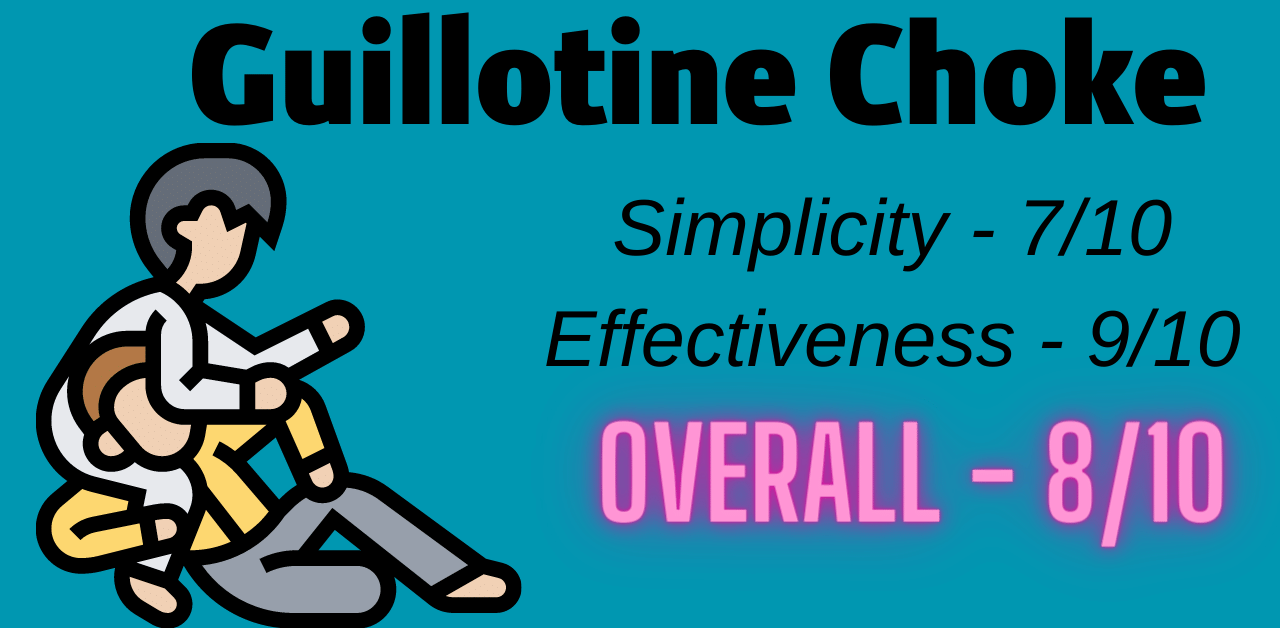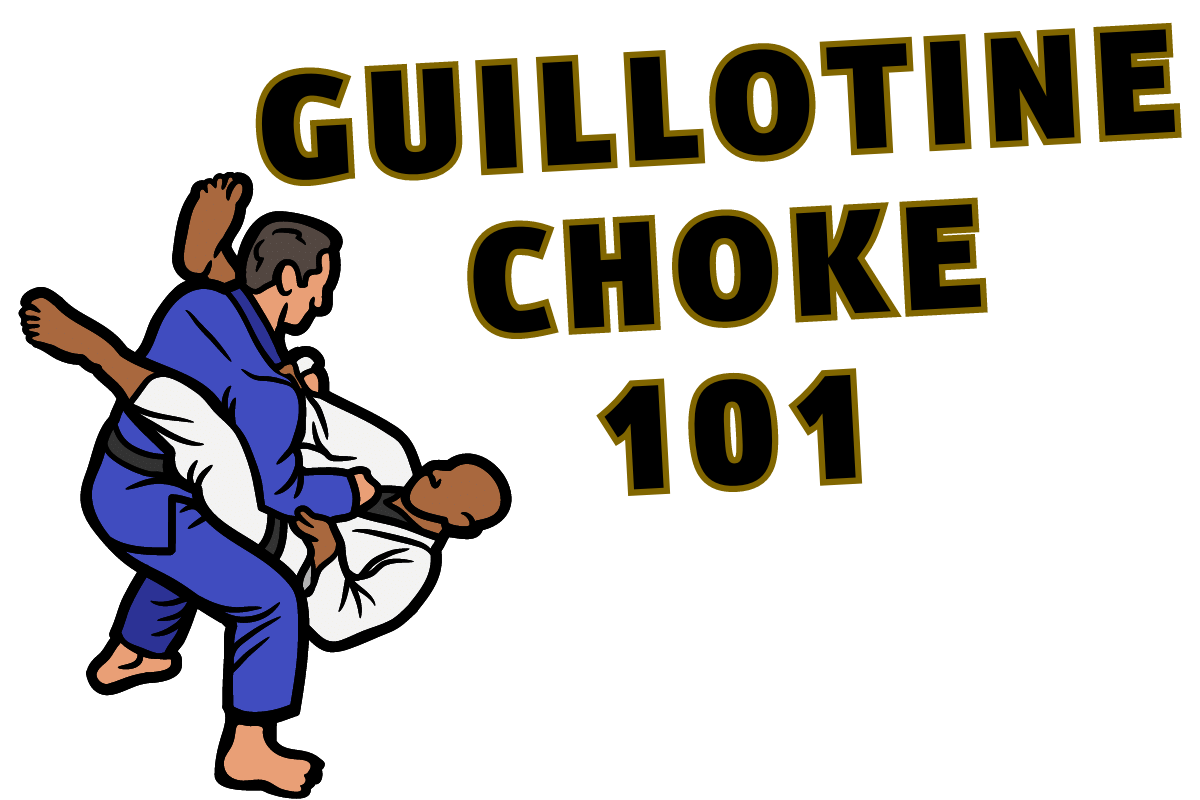The Guillotine device was popular in medieval times. Back then, people used it to execute people (typically as a punishment for betrayal or other severe crimes.) Today, people use the Guillotine differently. More specifically, it’s an inspiration for one of BJJ’s most effective submissions.
The Guillotine choke is a submission in Brazilian Jiu-Jitsu (also used in MMA) that utilizes upward pressure on the opponent’s neck to cut blood flow to the brain. It can be a deadly submission and might even cause long-term damage if applied after the opponent taps out.
So yes, you have to be extra careful when applying it. You don’t want to cause permanent damage, especially not to your training partners.
The Guillotine choke isn’t as complicated as other BJJ submissions. It’s much simpler than, let’s say, the Kimura. But each submission has its pros and cons: If you want to learn more about the Kimura and what makes it one of the most effective BJJ submissions, follow the link!
Eventually, if you apply all the steps accordingly, you’ll be submitting anyone if you get the Guillotine lock. It’s also a suitable choke for self-defense situations. People on the street don’t know how to defend against grappling techniques. As such, you’ll easily apply the choke and finish the fight swiftly.
This article aims to help you know the basic steps to perform the Guillotine choke correctly and effectively every single time. It’ll go through the small details you must get right to get the tap out from your opponent.
So, without further introduction, let’s dive in.

What is the Guillotine choke?
One of the ways people, back in history, executed other people was with the Guillotine device. However, it did another beautiful thing; it inspired a highly effective choke in the world of grappling. Let’s see what it is and what makes it so unique and practical.
The guillotine choke is a submission in BJJ that uses upward pressure to cut off blood flow to the brain. It utilizes pressure on the neck with one hand wrapped around the opponent’s neck (biceps facing down) and the other gripping the wrist. Then, upward pressure is applied until the tap out.
This can be a deadly, deadly choke. You don’t want to not be in complete focus when you apply it to your training partner.
Rather, once you have the Guillotine lock on the opponent, you want to be extra attentive to the tap out since it’ll come quicker than expected.
Overall, it really isn’t as complicated to execute as many folks think. For instance, performing it from the standing or the guard positions is easy to understand, and some will even say it’s an intuitive movement (unlike 90% of submissions.)
In short, it utilizes upward pressure on the neck to cut blood flow to the brain. It’s highly effective because it’s incredibly uncomfortable and painful. And thus, the tap-out will always come shortly after the lock is applied.
If you want to learn one of BJJ’s most effective chokes in the world, follow the link to read a complete guide to the Triangle choke. Understanding both the Guillotine and the Triangle will make you a competent grappler!
How to perform the Guillotine choke
This section will cover the Guillotine from the guard position. I’m confident it’s one of the most effective variations you can learn. It’s also relatively simple to execute, as it doesn’t require much understanding of movement and positions. Let’s see how you can perform it yourself:
To perform the Guillotine choke from the guard position; you start with the Kimura sweep position. Then, you lean forward and wrap your biceps around the opponent’s neck (with your biceps facing down.) The final step is to put all your weight on your hip and return to the guard position. Apply pressure and wait for the tap.
There it is—the Guillotine from the guard position. As you can see, it really isn’t as hard to execute as other submissions. It’s not impractical to learn it in just one training session.
That’s why I love this choke; it’s simple yet highly effective. If you’re a beginner grappler, you can benefit from learning this variation first, as it might give your first few wins, motivating you to keep learning.
Now, let’s review the mounted Guillotine choke.
A step-by-step guide to performing the Guillotine choke
Thus far, we’ve discussed the Guillotine variation from the guard position. In the following sections of this article, we’ll cover more variations, including standing while in the mount and even side control. Now, let’s go over the mounted Guillotine choke, which can be extremely effective and straightforward.
- Start in the mount position on your opponent, with your legs on either side of their body and your hips pressing into theirs.
- Reach your right arm across your opponent’s neck, placing your forearm under their chin and grabbing your left bicep with your right hand. Your left arm should be placed over your opponent’s right arm, with your left hand grabbing your right bicep.
- Squeeze your arms together, using your right forearm to apply pressure to your opponent’s windpipe and your left forearm to apply pressure to the carotid artery on the opposite side.
- As you apply pressure with your arms, use your body weight to drive your opponent’s head down and forward, increasing the pressure on their neck.
- Squeezing and driving your opponent’s head forward until they tap out or go unconscious.
There are many mistakes you can make when in the mount position. For instance, you can apply pressure in the wrong way. Make sure to apply the pressure upward while driving the opponent’s neck forward and not to the side.
Variations of the Guillotine choke
This part of the article will examine the 4 variations of the Guillotine. Of course, different grappling schools will teach different ways of performing it. As such, don’t fear learning other techniques and different ways of performing them.
Instead, be glad you can learn many variations and broaden your horizons. Learning different variations will grant you more knowledge regarding BJJ and submissions, making you a more knowledgeable grappler.
Guillotine choke from closed guard
I’ve already mentioned a variation of the Guillotine choke from the guard position. Now, let’s review another one I think some would prefer. Really, it doesn’t matter which one you’ll choose as much as choosing one and sticking with it.
You want to start with a guard position. You then want to force the opponent’s hands on the mat. Then, you lean forward while wrapping your hand around his neck (biceps facing down.) The final step is to fall back and cover his neck with your other hand. Now, apply pressure forward and upward.
That is it. This is the final guard variation we’ll discuss. Now, you can try both variations from this article yourself and see which one you prefer.
Guillotine choke from side control
Now, let’s review the side control variation of the Guillotine choke. Of course, this is the least used variation, other than the standing one. Unfortunately, it’s also relatively complicated and not as easy to learn as from the guard or the mount.
One of the more common ways is to switch from side control to a mounted Guillotine. However, this isn’t the variation we’ll discuss in this section. Alright, let’s dive in.
You first want to gain side control. Then, you underhook (not overhook) his triceps. You continue wrapping your hand with your biceps down around his neck. Then, you lock your hands together and squeeze while pushing your elbow down. Apply more pressure and wait for the tap.
It’s the most complicated variation out of all these ones. As such, it’ll be best to learn it last, as you can perform many other submissions from side control, which are more effective and give you less headache.
Anyway, this was the side control variation. Watch the following video to see it live.
If you’re having trouble passing people’s guard and getting into a better position, I wrote an article on how to pass anyone’s guard using the Toreando pass (one of the most effective passes in BJJ.) Make sure to follow the link to do it yourself.
Mounted Guillotine choke
We already reviewed this variation, so I’ll keep it as short and simple as possible.
You first want to get into your mount position. Once you’re there, you can start thinking about the Guillotine. What you want to do is get low and get under the opponent’s head. You want to grab the head so he will have difficulty putting it on the mat.
You then apply pressure on his shoulder with your other hand, forcing it toward his head. Next, you want to wait for him to pop his hand from your pressure. The final step is to wrap your hand around his neck in a short, fast movement.
You cut off his blood flow and air supply to the brain by creating upward pressure and driving his neck forward. Wait for the tap and stop creating pressure.
Or, in steps:
- Start from a mounted position
- Get low and create pressure on his head
- Grab his hand between himself and the mat
- Drive his shoulder with your other hand
- Force his shoulder in the direction of his head
- Once he pulls his hand outwards, wrap your hand around his neck
- Squeeze while creating upward pressure and driving his head forward
- Wait for the tap out
The primary mistake I see with this variation is not creating pressure in the right direction. You don’t want just to squeeze your biceps, although it can help. However, you want to create upward pressure while driving his neck forward.
Another mistake I see is not moving your hand around his neck concisely. You want this movement to be as quick as possible, so he won’t be able to resist, and that’s how you finish the mounted Guillotine.
Now, if you want to learn about another highly effective choke BJJ offers, I wrote a complete guide to perform the rear naked choke; give it a read if you want to become a better grappler!
Standing Guillotine choke
The standing Guillotine is a fantastic example of how you can win a BJJ fight before it even starts. Likewise, it’s an excellent variation to learn if you want to learn self-defense. Let’s see how you can perform it yourself:
- Start from your fighting position
- Punch the opponent to close the distance (optional step)
- Get close to the opponent
- Wrap your arm around his neck (with your biceps down)
- Grab your wrist with your other hand
- Apply pressure by puffing your chest
- Wait for the tap
Of course, if it’s a self-defense situation and your opponent is dangerous to others around you, you can use the pressure to ensure one doesn’t continue fighting afterward.
Many BJJ trainees apply slight pressure to keep the attacker in place until local authorities arrive. The best way to do that is by going for a mount position and staying there.
Eventually, the standing Guillotine is one of the best self-defense submissions. But, honestly, you won’t see it that often in your grappling class, as standing positions are less common than the guard or mount positions.
How effective is the Guillotine choke?
The Guillotine choke is one of BJJ’s signature moves. It can be a deadly submission when applied correctly. Although it only uses your hands and not your legs, which are stronger, the opponent will have no chance of fleeing from your Guillotine lock if you perform it correctly.
When performed correctly, the Guillotine choke is one of BJJ’s most effective submissions. However, it can lead to severe damage and potential death if the opponent doesn’t tap out. Additionally, it utilizes upward pressure to stop the blood flow to the brain, which will cause significant discomfort and high levels of pain.

It’s excruciating. You’ll immediately want to tap out when you have a Guillotine lock on your neck. The amount of pressure depends on how advanced your opponent is.
For example, many novice grapplers apply pressure to the side or sometimes even downward, which isn’t as effective as upward pressure. In that case, you’ll be more likely to hold on and remove the choke from your neck.
That said, if the opponent knows what he’s doing, he’ll be able to lock the Guillotine on you and not let go for several minutes. That’s why it’s highly effective.
If you want to learn about another highly effective BJJ submission, follow the link to learn about the straight arm lock and what makes it unique.
Is the Guillotine choke legal?
The Guillotine choke is a legal move in BJJ and MMA. Many of its variations can also be used in self-defense situations, where they’re highly effective. The only time you might get into legal trouble is when applying the Guillotine from a standing position and going to a guard position quickly.
This can cause permanent damage to the opponent’s spine and even neck. So make sure not to endanger the opponent, even if it will give you the win.
While BJJ is a sport of competition, and you want to use your entire physical force, the last thing you want is to force someone to deal with a severe injury for the rest of his life.
Conversely, it would be best not to fear using the Guillotine. It’s a rather safe submission if you release the pressure as the opponent taps out. The only thing you want to ensure is to have your undivided attention on the opponent when you have the Guillotine lock.
Which martial arts teach the Guillotine choke?
The primary martial art that teaches the Guillotine choke is BJJ. However, many UFC fighters have implemented this choke into their game. As a result, you can say that MMA teaches the Guillotine as well. Jiu-Jitsu, however, is where this submission originates from.
BJJ also teaches the wrist lock, one of the simplest submissions in the entire world. Follow the link to read more about the wrist lock and how to learn it today!
What happens if you don’t tap into a Guillotine choke
The Guillotine choke cuts off blood and air supply to the brain. If you don’t tap the Guillotine, you’ll quickly go unconscious. If the pressure continues after this point, permanent and severe damage to the neck and spine are inevitable. Likewise, potential death after this point is possible.
So, make sure to watch out for the opponent when you apply this choke. I know how quickly someone can go unconscious when the Guillotine is locked around their neck. It can be just a few seconds. Thus, stop applying the pressure immediately after feeling the tap.
Before we wrap up this article if you want to learn about the Armbar and how to perform it correctly, follow the link!
Final words
Congratulations, you now know everything you need about the Guillotine choke. You can start learning it and mastering it.
The Guillotine choke is one of BJJ’s signature submissions. Therefore, applying this choke will not be as tricky as some other martial art submissions.
Likewise, you’ll have an even easier time going for the Guillotine in self-defense. Most people don’t know how to defend against grappling moves. As a result, you’ll have it easy when applying such a technique in self-defense.
Paying attention to the opponent when you have the lock is more than necessary. We saw what cutting the blood, and air supply to the opponent’s brain can do in the long term. So, make sure to stay away from such injuries.
If you want to become a better grappler, I wrote an article about the absolute best BJJ techniques you want to learn. While the Guillotine is an effective choke, it’s not on my best techniques list. Make sure to follow the link to find out which ones you should really learn.

